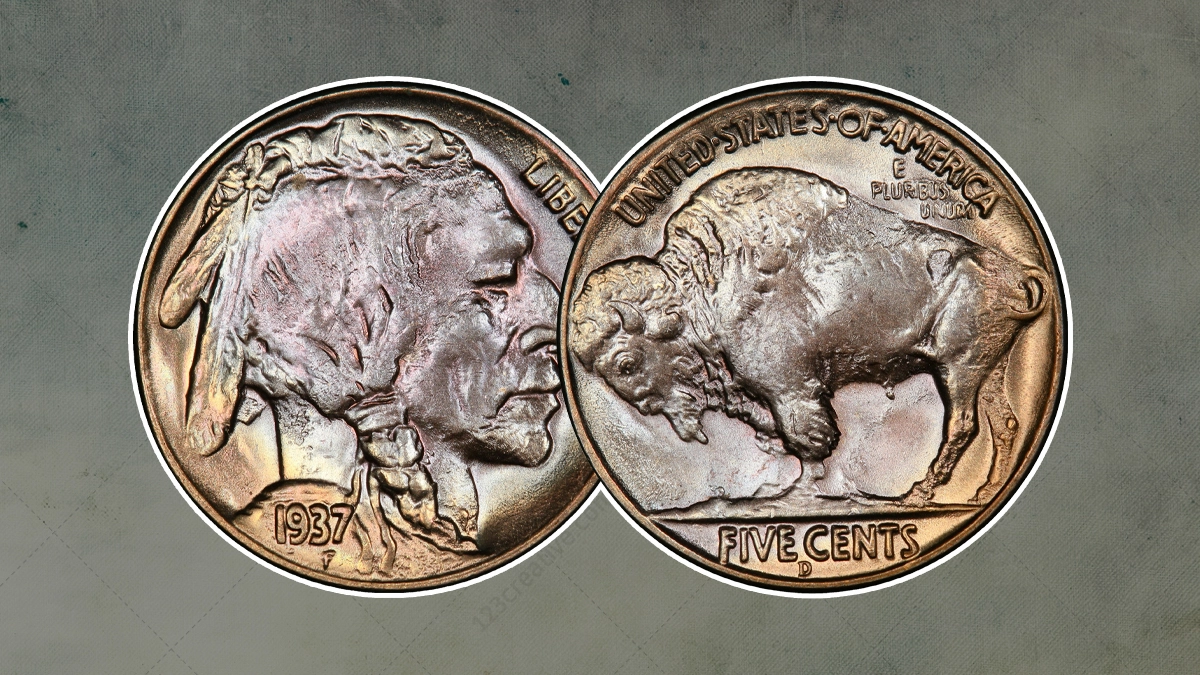
The 1937 Buffalo Nickel has a special place in coin collectors’ hearts and earned a spot in numismatic lore because of the most sought-after coin errors in history.
In this article, we’ll explore the history, specification, unique design, and continuing legacy of this special coin.
History of 1937 Buffalo Nickel
The Buffalo Nickel was the first time an animal appeared on a U.S. nickel. James Earle Fraser’s design not only impressed mint administrators back then but continues to be admired to this day.
The stunning descriptions of a Native American, encouraged by authentic Indigenous individuals, alongside the majestic bison, act as strong symbols and an honor to the land’s rich heritage. These images are an iconic celebration of American history, a reminder of the ancestors who deserve credit.
Specification:
Designer: James Earle Fraser
Edge: Plain
Diameter: 21.20 millimeters
Weight: 5.00 grams
Mintage: 79,480,000
Mint: Philadelphia
Metal Composition: 75% Copper, 25% Nickel
Design
The Buffalo Nickel is the US five-cent coin, an iconic of American coinage. It is made up of 75% Copper and 25% Nickel. The Buffalo Nickel debuted in 1913 and it was replacing the old design, the Liberty Head Nickel.
Obverse
The portrait on the obverse is a study of three Native American models with the Indigenous man’s faces right. The word LIBERTY is inscribed on the external edge and the date is found on his shoulder.
Reverse
The reverse was styled from an American bison, commonly named a “buffalo.” The bison stands on an extended mound, and also with the text “UNITED STATES OF AMERICA” and “E PLURIBUS UNUM” above. The face value, “FIVE CENTS”, is seated on the below side.
Rarity
A coin’s value hinges on its mintage figure. Each year, mint facilities have variable numbers of coins, making certain years and mint marks scarcer than others. Rarity is determined by how many specimens remain on the open market since the coin is no longer in production.
The 1937 Buffalo Nickels are not extremely rare in circulated grades but become much more difficult to find in better conditions due to their high popularity. Numismatists always prioritize coins that have survived the passage of time while maintaining their original luster. Therefore, coins in good condition grow to be more expensive.
Coin Grading
Two well-known professional grading services are PCGS and NGC. Both are respected third-party services that provide accurate assessments of a coin’s authenticity and value. Coins sent to them are graded using the Sheldon scale, which rates coins from 1 to 70 based on their condition, with 1 being very poor and 70 representing a perfect state.
As expected, the better a coin’s condition, the higher its potential price. While grades alone do not guarantee a coin’s value, they do validate its origin and authenticity.
Circulated coins
Coins in circulated grades (1-50) are usually in poor condition and less attractive to collectors. Their condition varies from showing significant wear to being almost unrecognizable with little to no actual luster. A “broken reflection” means the coin no longer reflects light properly, representing it has lost most of its luster and is therefore regarded as circulated.
Uncirculated coins
Uncirculated coins will show little to no wear signs (60-69) until they are perfect in view, with all their actual reflection or luster intact (70). The older the coin, the more difficult it is to find a sample in an uncirculated condition.
Errors
1937 Buffalo Nickel Regular Strike
The Philadelphia Mint produced the 1937 Buffalo Nickel 79,480,000 units. These samples have no mint marks.
The auction record is $18,213 in 2014 for a 1937 Buffalo Nickel Regular Strike for an MS68 sample.
1937-D Buffalo Nickel Regular Strike
1937 Nickels were also produced 17,826,000 units in the Denver branch of the US Mint. These were produced with the “D” mint mark on the reverse, right below the face value inscription.
So, the 1937-D Buffalo Nickel is lower than the ones made in Philadelphia with no mint marks.
The auction record is $35,250 for this variation in 2015 for an MS68 sample.
1937-S Buffalo Nickel Regular Strike
An extra 6,635,000 Buffalo Nickels were produced by Mint in 1937 in San Francisco. These coins contained the “S” mint mark stuck below the “FIVE CENTS” inscription on the reverse.
The auction record is $29,900 for a 1937-S Buffalo Nickel in 2007 for an MS68 specimen.
1937-D 3-Legged Buffalo Nickel
The 1937–D “three-legged” nickel is the most recognized error coin of the Buffalo Nickels series.
At the Denver mint, a pressman named Mr. Young reportedly over-polished a die to remove marks, inadvertently erasing part of the bison’s leg. Before the error was detected, thousands of these coins were released, becoming a famous collectible among coin enthusiasts.
According to PCGS, this error coin is one of the most important coins of the 20th century with scarcity in circulated conditions, but in uncirculated conditions, it can be viewed as very rare with its rarity influencing its price and popularity.
A three-legged nickel-graded MS66 was sold for $99,875.00 in 2021, at Legend Rare Coin Auctions.
1937 Buffalo Proof Coin
1937 marked the last year the US Mint produced a proof version of the Buffalo Nickel. Although not extremely rare, these proof coins are highly sought after by collectors and can be valued at around $95,000 in pristine condition, according to the PCGS price guide.
The proof version features a brilliant, mirror-like finish due to a hand-polished planchet, highly polished dies, and being struck at least twice. This finish, along with the coin’s history, enhances its collectible value.
Where To Buy/ Sell 1937 Buffalo Nickel?
The most practical approach is to go to online auction sites and other online markets to buy or sell 1937 Buffalo nickel. Here many sellers set bids on websites like eBay, Etsy, Amazon, and Craigslist. However, you can buy or sell at the coin antique shops for your 1937 Buffalo nickels. But finding one can be more difficult.
It is also necessary to pursue help from reputed coin grading service providers, PCGS and NGC if you want advice on where and how to buy or sell your 1937 Buffalo nickels.
Also Read – 1921 High Relief Peace Dollar: A Numismatic Rarity
Conclusion:
In this article, we discussed the 1937 Buffalo nickel coin’s history, design, and errors. You know that a coin’s condition, rarity, price, and error coins are usually valuable because of their historical importance.
